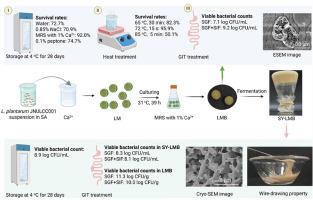Alginate microcapsules enriched with biofilm-like Lactiplantibacillus plantarum: characterization, stability, and application in fermented soy yoghurts
IF 11
1区 农林科学
Q1 CHEMISTRY, APPLIED
引用次数: 0
Abstract
Probiotic viability easily decreases during oral delivery, preparation, transportation, and storage processes. Here, we developed a dual encapsulation strategy based on sodium alginate (SA)/Ca2+ crosslinking and in situ formation of biofilm to protect Lactiplantibacillus plantarum (L. plantarum) from the adverse environments and used the encapsulated L. plantarum to prepare fermented soy yoghurt. First, L. plantarum with excellent exopolysaccharide-producing ability was encapsulated in the SA gel to form L. plantarum microcapsules (LMs). Then, LMs were cultured in MRS broth with 1 % Ca2+ to form the LM biofilm (LMB) with a probiotic loading of 1.5 × 1012 CFU/g. The established LMB showed excellent resistance to the gastrointestinal tract and elevated temperatures. After 28 days of storage at 4 °C, LMB still exhibited high viable bacterial counts (8.7 log CFU/g). Moreover, LMB can be used as a starter culture to prepare fermented soy yoghurt (SY-LMB) with excellent rheological properties. The viable bacterial counts in SY-LMB reached 12.6 log CFU/mL after 21 days of storage, which was much higher than that of the commercial soy yoghurts (9.1 log CFU/mL). More importantly, after digestion with gastrointestinal fluids, the viable bacterial counts in SY-LMB and LMB were still as high as 8.1 log CFU/mL and 10.0 log CFU/g, respectively. Overall, we provided a very effective dual encapsulation strategy that can efficiently improve the survival rates of probiotics in the harsh environments and provided an effective starter culture for preparing the plant-based yoghurt.

富含植物乳杆菌生物膜的海藻酸盐微胶囊:特性、稳定性及其在发酵大豆酸奶中的应用
益生菌的活力在口服、制备、运输和储存过程中容易降低。本研究采用海藻酸钠(SA)/Ca2+交联和原位形成生物膜的双重包封策略,保护植物乳杆菌(L. plantarum)免受恶劣环境的侵害,并利用包封后的植物乳杆菌制备发酵大豆酸奶。首先,将具有良好胞外多糖生成能力的植物乳杆菌包被在SA凝胶中形成植物乳杆菌微胶囊(LMs)。然后,在含1% Ca2+的MRS肉汤中培养LM,形成益生菌负荷为1.5 × 1012 CFU/g的LM生物膜(LMB)。建立的LMB对胃肠道和高温表现出良好的抵抗力。在4°C下保存28天后,LMB仍然具有较高的活菌计数(8.7 log CFU/g)。此外,LMB可作为发酵剂制备具有优良流变特性的发酵大豆酸奶(SY-LMB)。SY-LMB的活菌数在贮存21天后达到12.6 log CFU/mL,远高于商品大豆酸奶(9.1 log CFU/mL)。更重要的是,经胃肠道液体消化后,SY-LMB和LMB中的活菌数量仍高达8.1 log CFU/mL和10.0 log CFU/g。总的来说,我们提供了一种非常有效的双包封策略,可以有效地提高益生菌在恶劣环境下的存活率,并为制备植物性酸奶提供了有效的发酵剂。
本文章由计算机程序翻译,如有差异,请以英文原文为准。
求助全文
约1分钟内获得全文
求助全文
来源期刊

Food Hydrocolloids
工程技术-食品科技
CiteScore
19.90
自引率
14.00%
发文量
871
审稿时长
37 days
期刊介绍:
Food Hydrocolloids publishes original and innovative research focused on the characterization, functional properties, and applications of hydrocolloid materials used in food products. These hydrocolloids, defined as polysaccharides and proteins of commercial importance, are added to control aspects such as texture, stability, rheology, and sensory properties. The research's primary emphasis should be on the hydrocolloids themselves, with thorough descriptions of their source, nature, and physicochemical characteristics. Manuscripts are expected to clearly outline specific aims and objectives, include a fundamental discussion of research findings at the molecular level, and address the significance of the results. Studies on hydrocolloids in complex formulations should concentrate on their overall properties and mechanisms of action, while simple formulation development studies may not be considered for publication.
The main areas of interest are:
-Chemical and physicochemical characterisation
Thermal properties including glass transitions and conformational changes-
Rheological properties including viscosity, viscoelastic properties and gelation behaviour-
The influence on organoleptic properties-
Interfacial properties including stabilisation of dispersions, emulsions and foams-
Film forming properties with application to edible films and active packaging-
Encapsulation and controlled release of active compounds-
The influence on health including their role as dietary fibre-
Manipulation of hydrocolloid structure and functionality through chemical, biochemical and physical processes-
New hydrocolloids and hydrocolloid sources of commercial potential.
The Journal also publishes Review articles that provide an overview of the latest developments in topics of specific interest to researchers in this field of activity.
 求助内容:
求助内容: 应助结果提醒方式:
应助结果提醒方式:


